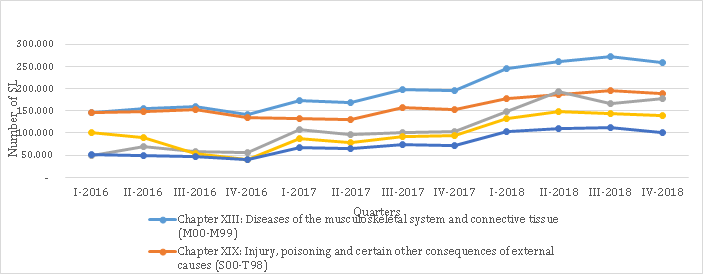Sick Leave in Colombia in the 2016-2018 period: A Retrospective Cross-Sectional Observational Study
Licencia por enfermedad en Colombia en el período 2016-2018: Estudio observacional transversal retrospectivo
How to cite: Valero-Pacheco IC, Riaño-Casallas MI, García-Bedoya O, Rodríguez-Páez FG, Cardona F, Téllez-Avila EM, et al. Sick Leave in Colombia in the 2016-2018 period: A Retrospective Cross-Sectional Observational Study. Univ Salud. 2022; 24(3):218-26. DOI: https://doi.org/10.22267/rus.222403.276.
Abstract
Introduction: To understand the sick leave situation and the causes and effects of a temporary loss of capacity to work allows for the strengthening of policies and management in the provision of health services. Objective: To analyze sick leave in Colombia in the 2016-2018 period. Materials and methods: A retrospective cross-sectional observational study and the relative risk was calculated. Sick leave reports were provided by the Ministry of Health and Social Protection. 12,410,837 reports from formal workers between the ages of 18-70 years and had at least one temporary disability were processed. Results: The average age of people with sick leave was 37.11 years, 53% corresponding to females. On average, sick leave was 90.6% and 5.6% for dependent and independent workers, respectively. The principal causes of disability were musculoskeletal diseases and were more likely in men and adults according to RR. Men in comparison to females and adults in comparison to youths are less likely to have sick leave due to respiratory disease. Conclusions: In Colombia, females presented more temporary sick leave, even if males had more days of disability, even though the median was three days in both genders. Youth and adults had more sick leave days.
Keywords: Sickness absence; sick leave; disability insurance; delivery of health care; public health surveillance.
Resumen
Introducción: Comprender la situación de incapacidad por enfermedad, causas y efectos de una pérdida temporal de la capacidad de trabajo fortalece las políticas y la gestión en la prestación de servicios de salud. Objetivo: Analizar las incapacidades por enfermedad en Colombia en el período 2016-2018. Materiales y métodos: Estudio observacional transversal retrospectivo, con cálculo del riesgo relativo. Se procesaron 12.410.837 registros de trabajadores formales entre 18 y 70 años de edad y con al menos una incapacidad temporal, según los informes del Ministerio de Salud y Protección Social. Resultados: La edad promedio de las personas fue de 37,11 años, 53% fueron mujeres. En promedio, el 90,6% de las incapacidades fue para trabajadores dependientes y el 5,6% trabajadores independientes. Las principales causas de incapacidad fueron las enfermedades del sistema musculoesquelético más frecuentes en hombres adultos según RR. Los hombres en comparación con las mujeres y los adultos en comparación con los jóvenes tienen menos probabilidades de tener licencia por enfermedad respiratoria. Conclusiones: Las mujeres presentaron más incapacidades temporales por enfermedad, aunque los hombres tuvieron más días de incapacidad, la mediana fue de tres días en ambos géneros. Los jóvenes y los adultos tenían más días de baja por enfermedad.
Palabras clave: Ausencia por enfermedad; baja laboral por enfermedad; absentismo por enfermedad; licencia por enfermedad; días de baja por enfermedad.

